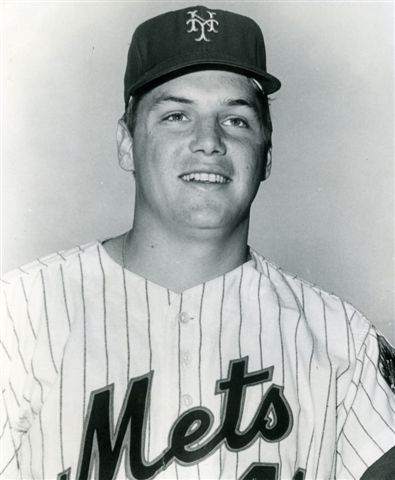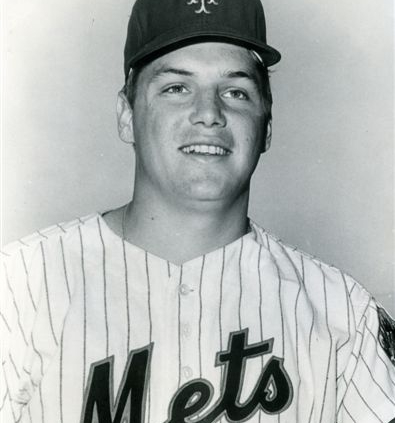August 13, 1967: Tom Seaver pitches his first career shutout for Mets
 Against a Pittsburgh Pirates lineup whose first three batters were each hitting .300 or above (Maury Wills at .300, Matty Alou at .303, and Roberto Clemente at .344), New York Mets rookie Tom Seaver pitched his first major-league shutout in the first game of a doubleheader on August 13, 1967. New York’s 3-0 win was also Seaver’s 12th win of the season, the most of any Mets right-hander in the franchise’s six-season history.
Against a Pittsburgh Pirates lineup whose first three batters were each hitting .300 or above (Maury Wills at .300, Matty Alou at .303, and Roberto Clemente at .344), New York Mets rookie Tom Seaver pitched his first major-league shutout in the first game of a doubleheader on August 13, 1967. New York’s 3-0 win was also Seaver’s 12th win of the season, the most of any Mets right-hander in the franchise’s six-season history.
“The story of how Seaver landed with the Mets is a little miracle in itself.”1 Selected by the Los Angeles Dodgers from the University of Southern California in baseball’s first amateur draft in 1965, Seaver refused to sign because the Dodgers’ offer was insufficient.
The Atlanta Braves picked him in 1966 in a special draft for unsigned players. Seaver agreed to sign with the Braves but reached the deal after the college baseball season had begun, so Commissioner Spike Eckert voided it. Though Seaver had not received any money from the Braves, the NCAA then declared him ineligible for college competition.
With Seaver’s family threatening a lawsuit, baseball held a “special lottery” in April 1966 for any teams willing to match Atlanta’s offer. Three clubs participated: the Mets, Philadelphia Phillies, and Cleveland Indians. The Mets won Seaver’s rights and signed him.2
Soon afterward, Seaver started his professional career in Triple A with the Jacksonville Suns of the International League. He led the IL in starts (32), was second in strikeouts (188), tied for eighth in wins (12) and complete games (10), and tied for fourth in shutouts (4).
After only one minor-league season, the 22-year-old Seaver made his big-league debut against the Pirates in the Mets’ second game of the 1967 season on April 13. Though the Mets won, 3-2, Seaver received a no-decision.
His first major-league win came seven days later, with 7⅓ innings of one-run work against the Chicago Cubs. Another milestone followed in his next start, on April 25, his first complete game, a 10-inning, 2-1 win over the Cubs. Shaking off an unearned run with two outs in the ninth, Seaver singled and scored the go-ahead run in the 10th, then retired Chicago in order to close out the win.3
Seaver finished both April and May with 2-1 records, struggled a bit in June with three losses in five decisions, then won four of six starts in July. After splitting his first two decisions in August, he was 11-8 with a 3.12 ERA.
Clearly, Seaver had brought something new to the Mets, who were 10th of 10 National League teams in each of their first four seasons of existence, then ninth in 1966. Entering their August 13 doubleheader with the Pirates, the 1967 Mets were again in last place, with a 44-66 record, but had won 14 of Seaver’s 23 starts. Only one Met had won more games than Seaver had in just four months – lefty Al Jackson was 13-17 in 1963, and even bigger targets were in sight.
“When Seaver won his 11th by beating the Braves, 5-1, on August 9, and someone kiddingly suggested to [Mets manager] Wes Westrum that Tom might win 20, the manager turned serious and replied, ‘I wouldn’t bet against it,’” The Sporting News reported.4
Seaver faced Pittsburgh on August 13 still seeking his first career shutout. Besides his near-miss against the Cubs in April, his 11 complete games had included two in which he allowed only one run.
The Sunday afternoon contest began at 1:05 P.M. before a crowd of 34,122. Seaver was pitching on only three days of rest for just the fourth time. As a rookie he generally had four days off between starts.
“‘If he’d had a couple of years in the minors behind him, we’d pitch him more often,” Westrum said. “But this boy had only one year in Triple-A before coming up to the majors. That’s not very much experience.’”5
For seven innings it was a scoreless duel between Seaver and 25-year-old right-hander Steve Blass. Blass entered with a 2.94 ERA in 23 appearances, including nine starts. On June 26, during Pittsburgh’s previous visit to Shea Stadium, he had blanked the Mets until Ken Boyer’s two-run homer with two outs in the eighth tied the game; New York won with a ninth-inning run against Pittsburgh’s bullpen.
Seaver made it through his first encounter with the Pirates’ parade of .300 hitters unharmed, as Clemente6 grounded into a double play to negate Alou’s one-out single in the first.
After Bud Harrelson and Bob Johnson grounded out in the bottom of the first, the Mets threatened against Blass. A walk, single, and walk loaded the bases, but Ed Charles’s groundout put a zero on the scoreboard.
The Pirates’ lineup offered only a mild break in the second, as left fielder Willie Stargell, an emerging power threat at age 26; second baseman Bill Mazeroski, with a World Series-winning home run in 1960 alongside his record of defensive excellence; and first baseman Donn Clendenon, who earned World Series MVP honors two years later as a Met, were up. But Seaver again handled the challenge, walking Mazeroski but fanning Clendenon and Jose Pagan to end the inning.
Blass held up his half of the pitching duel into the eighth, repeating his performance at Shea Stadium in June. The Mets managed Cleon Jones’s leadoff double and Seaver’s one-out walk in the second, Tommy Davis’s leadoff single in the third, and Ron Swoboda’s one-out single in the sixth, but could not advance a runner past second.
Seaver was even more effective. Alou’s fourth-inning walk was Pittsburgh’s only baserunner between the third and sixth innings, and he was erased when Clemente again grounded into a double play. When Wills grounded out to end the sixth, Seaver had retired eight Pirates in a row.
Alou’s single to lead off the Pirates’ seventh snapped Seaver’s streak. Clemente followed by nearly grounding into his third double play of the game, as Bob Johnson turned his grounder to second into a force on Alou, but umpire Frank Secory ruled Clemente beat Harrelson’s relay to first in a disputed call.7
One out later, Mazeroski’s single gave the Pirates runners at the corners, but they were stranded when Swoboda made “a tremendous diving catch of Donn Clendenon’s line drive in short right.”8
Blass and Seaver exchanged two more scoreless half-innings, and the game remained deadlocked entering the Mets’ half of the eighth. Blass seemed headed to another clean inning when he retired Harrelson and Johnson on comebackers.
But Davis singled to center, the Brooklyn native’s second hit of the game. Swoboda’s third hit, a “surprise bunt”9 single to third, put Davis in scoring position.
Then came the game’s two clutch hits. Kranepool blooped a single to right, scoring Davis to break the scoreless tie. Charles followed with a double, and Swoboda and Kranepool came home with insurance runs for a 3-0 lead.
Seaver needed just three more outs for his first career shutout, but suspense returned one last time in the top of the ninth. After Wills lined out, Alou walked, the fourth consecutive time he reached base. Clemente singled to center, putting runners on first and third with one out.
The tying run was at the plate, with Stargell and Mazeroski – like Seaver, bound for the Hall of Fame – coming up. Once again, Seaver showed the form that drew so much interest in college and carried the Mets to victory many times over the years to come. Stargell hit a popup to shortstop and Mazeroski lined out. The shutout was complete.
It was only the third time in 1967 that the Pirates had been shut out. They finished the season with the highest team batting average in the NL at .277, while also leading the league in on-base percentage and slugging percentage and finishing third in runs scored.
In his game story, New York Times sportswriter Joseph Durso referred to Seaver as “the Rembrandt of the pitching staff.”10 Mazeroski offered this praise of Seaver’s performance: “He pitches more like a veteran than a rookie.”11 With a 12-8 record, Seaver now had more wins in a season than any right-hander in franchise history, passing three pitchers – Jack Fisher, Dennis Ribant, and Bob Shaw – who had 11 wins apiece in 1966.
New York finished in last again in 1967, but Seaver signaled a better future, receiving NL Rookie of the Year honors with a 16-13 record and 2.76 ERA. In his next-to-last start of the season, Seaver pitched his second shutout, beating the Houston Astros 1-0, the lone run scoring in the bottom of the ninth on Jerry Buchek’s walk-off single.
Seaver pitched 61 shutouts in his 20-season career, his last with the Chicago White Sox in 1985 at age 40. Coincidentally, among major-league pitchers since 1967, the only one to match Seaver’s career shutout total was Nolan Ryan, his teammate for several seasons with the Mets. Seaver’s 44 shutouts with the Mets remain the franchise record in 2022.
Author’s Note
Because of both pitchers’ efficiency and proficiency (for most of the game), it played much faster than the average game time in 1967 of 2:37, as its game time was only 2 hours and 6 minutes.
Acknowledgments
This article was fact-checked by Bruce Slutsky and copy-edited by Len Levin.
Sources
In addition to the sources cited in the Notes, the author consulted Baseball-Reference.com and Retrosheet.org for player, team, and season data.
https://www.baseball-reference.com/boxes/NYN/NYN196708131.shtml
https://www.retrosheet.org/boxesetc/1967/B08131NYN1967.htm
Notes
1 David Schoenfield, “Tom Seaver Transformed the New York Mets and Transfixed Their Fans,” ESPN, September 2, 2020, https://www.espn.com/mlb/story/_/id/29798240/tom-seaver-transformed-new-york-mets-transfixed-their-fans.
2 Schoenfield.
3 In his next 20 starts, Seaver pitched 11 more complete games.
4 Jack Lang, “Ex-Alaska Goldpanners Seaver, Frisella Hit Pay Dirt with Mets,” The Sporting News, August 26, 1967: 15.
5 Lang.
6 Clemente finished the 1967 season with a .357/.400/.554 slash line, his league-leading .357 batting average the highest of his career. However, in all his at-bats against Seaver, he hit .242.
7 Clemente “seemingly reaching [first base] a full step behind the ball from shortstop Bud Harrelson.” Dana Mozley, “Mets Belt Pirates, 3-0, Leave the Cellar,” New York Daily News, August 14, 1967: C26.
8 Mozley.
9 Mozley.
10 Joseph Durso, “Mets Down Pirates, 3-0, on Seaver’s 4-Hitter and Then Win, 11-9,” New York Times, August 14, 1967: 40.
11 “Bunts and Base Hits,” Pittsburgh Post-Gazette, August 14, 1967: 28.
Additional Stats
New York Mets 3
Pittsburgh Pirates 0
Game 1, DH
Shea Stadium
New York, NY
Box Score + PBP:
Corrections? Additions?
If you can help us improve this game story, contact us.


